We may receive a commission when you use our affiliate links. However, this does not impact our recommendations.
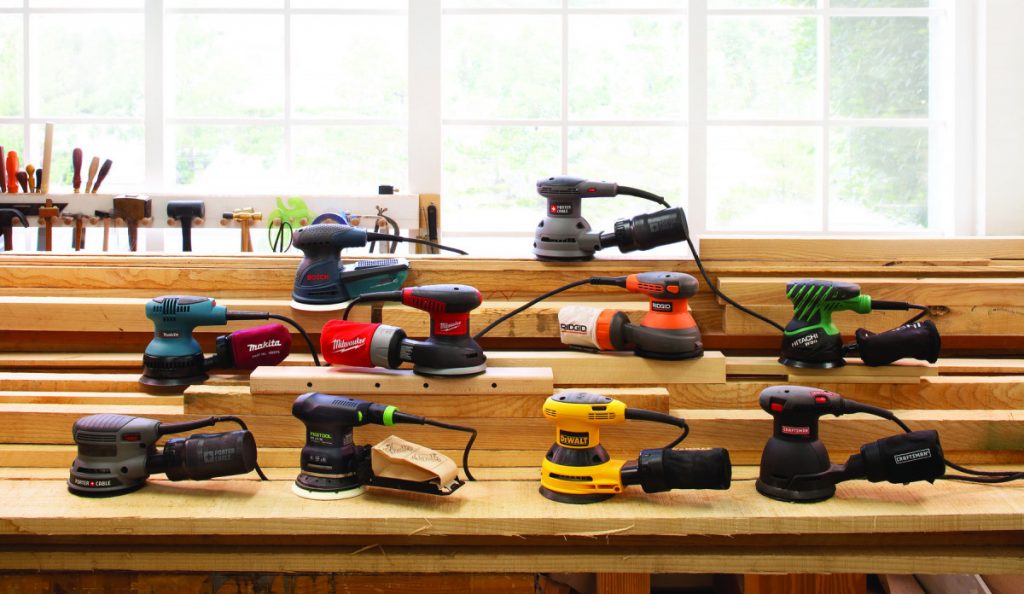 As we prepared to test random-orbit sanders, we considered the vast number of tools available. In order to make the test manageable, we decided to limit the test to variable- speed tools with 5″ pads.
As we prepared to test random-orbit sanders, we considered the vast number of tools available. In order to make the test manageable, we decided to limit the test to variable- speed tools with 5″ pads.
The reason for selecting tools with 5″ pads is that most stores carry a wide variety of grits in that size. But why should you purchase a variable-speed sander versus a single-speed sander that costs a few dollars less? Where it helps, in our opinion, is when you have to deal with boards that aren’t exactly flat, such as where you’ve worked a glue seam with a scraper and ended up with a slight valley on the surface. A sander can move wildly as you traverse that valley. At high speeds the sander has the potential to “walk” and create sanding scratches that require additional attention. Slower speeds allow more control.
Next, we envisioned an article full of charts demonstrating how different these sanders are. But as testing began, we discovered that each sanders does the job it is supposed to do. Each one sands a surface smooth and flat without leaving huge swirls.
What we found to be the most important aspects of these sanders were attributes that do differentiate the tools: How the tool fits your hand, whether the switch is easily accessible to most hands, and how easy the tool is to control. The other important issues are dust collection and whether or not the tool is aggressive.
A Five-minute Stock-removal Test
In order to test the tools’ aggressiveness and dust collection, we ran the sanders through a simple five-minute test. Pieces of surfaced poplar were cut to the same size and weighed to three decimal places.
Then we sanded each board for five minutes using an identical, unused #120-grit sanding disc. (The Festool sander uses a Festool disc due to the hole patterns.) When the fiveminute cycle was complete, we weighed each board to find the amount of stock removed. At the same time we evaluated the dust collection of the sanders, noting any dust that was deposited on the tool, that was left on the board or was visible in the air.
A look at the amount of stock removed should also involve a study of the orbit diameter of each sander. That diameter influences the aggressiveness of the machine. For example, the Festool sander was the least aggressive at removing stock, and it has the smallest orbit diameter of the group. The Porter-Cable 390 is the most aggressive sander tested. It removed more than a half ounce of waste, but it didn’t have the largest orbit diameter. That honor goes to Craftsman. The Craftsman 11218 sander ranked second in stock removal. A quick look at the chart on page 62 will give you an idea as to where each tool placed.
Dust Collection Design and Ability
We’ve all seen or experienced the canister or bag falling off a sander and a cloud of dust bellowing out. That’s not good. So a study of dust collection has to begin with how the receptacle attaches to the sander.
Here we give kudos to the Ridgid R2600 because the bag is attached to a frame that’s screwed to the body of the sander. There’s no chance this receptacle would fall off.
The Porter-Cables, DeWalt and Milwaukee have either a canister or bag that twists and locks onto transition pieces that are attached to the sanders’ bodies.
While Porter-Cable has shown improvements over its earlier models, the transition pieces simply press-fit over an O-ring gasket. The O-ring tightens the connection. The Porter- Cable 390 sander showed quite a bit of dust around the sides of the body just above the pad. We also noticed airborne dust while using this tool when we worked near edges.
DeWalt and Milwaukee each have transition pieces firmly affixed to the sander. The DeWalt sander showed a small amount of residual dust at the front of the tool just above the pad, and the Milwaukee sander exhibited a large amount on the dust bag at the seams.
The Makita, Craftsman and Hitachi tools have other dust-collection issues.
The Makita sander has a bag twist-locked onto a transition piece, but the transition piece slides over a tube-like dust port and can easily be removed. There are no O-rings to tighten the fit.
The Craftsman sander has a frame that’s holding a cloth bag, but the frame simply slides onto a 1 3/8″ tube-like port; again no O-ring.
The Hitachi sander has a loose-fitting bag affixed to a transition piece that slides onto the tool. Not only is there no gasket or Oring, but due to the shape of the fitting, there’s no method for hooking the sander directly to a vacuum (something other sanders have addressed. The Makita requires a separately purchased accessory). The dust collection was poor – dust gathered over the entire base of the tool and was concentrated where the bag meets the transition piece.
The Festool sander has a paper bag for dust collection. If you’re a Festool user, you probably have an external vacuum. Without a vacuum, this sander ranks in the middle of the pack. And I don’t think having to buy replacement paper bags is ideal.
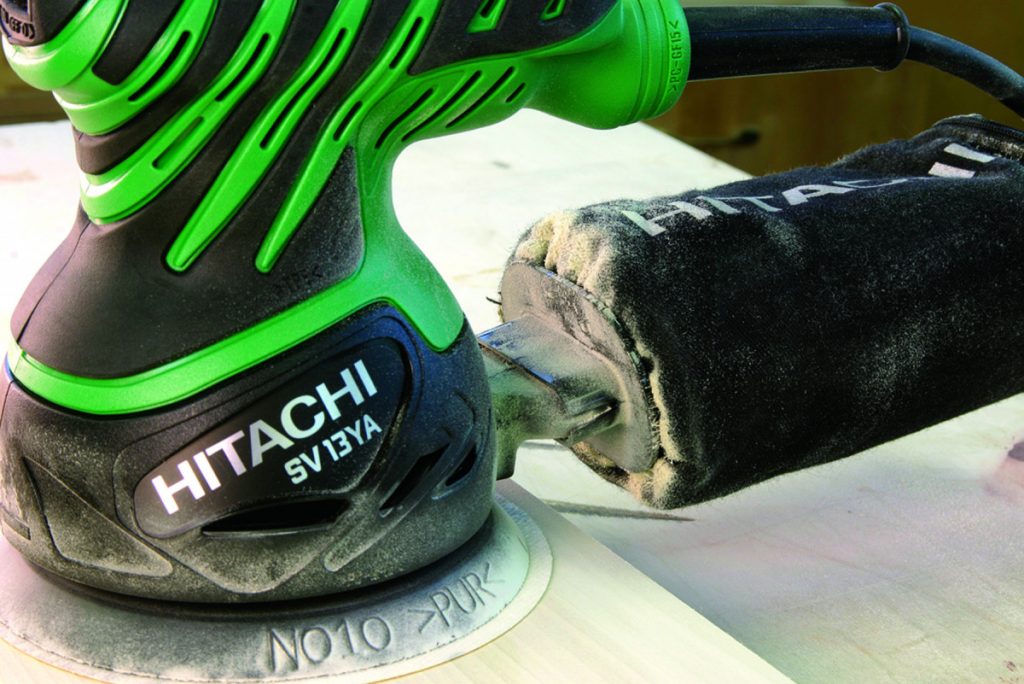
Residual dust is all around the body and bag on this sander. If you see dust here, it’s in the shop air too.
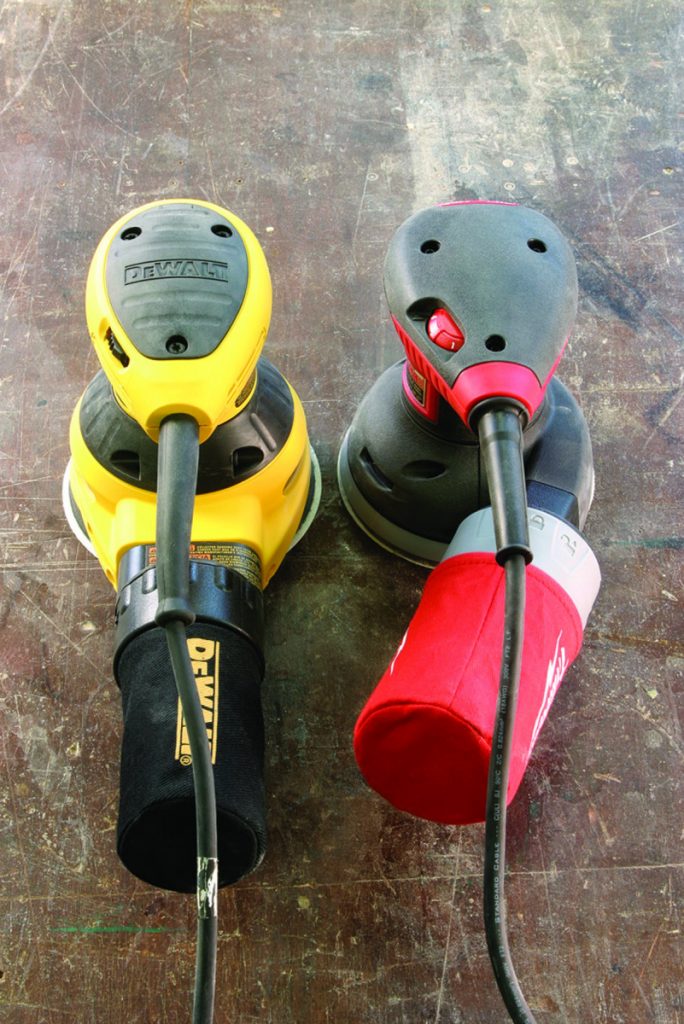
The Milwaukee sander’s dust collection bag has a bit of a turn as it meets the tool’s body. It was just enough to cause me to adjust my stance and feel uncomfortable.
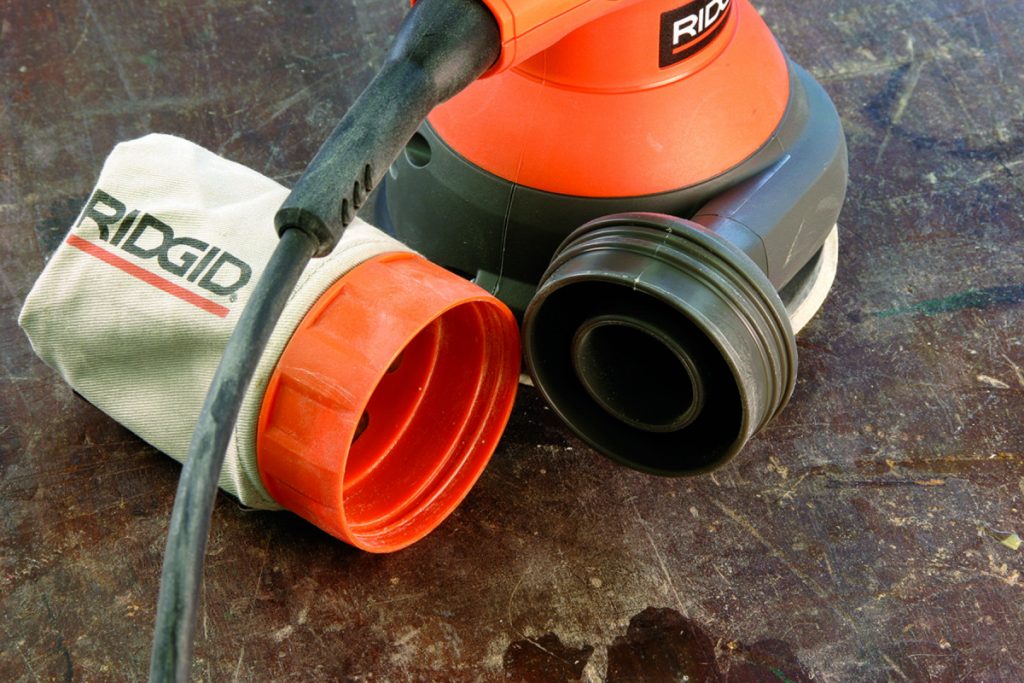
By attaching the dust collection to the tool via screw threads, it’s highly unlikely the dust bag will fall from the tool.
A Sander in the Hand
Regardless of stock removal or dust collection, if a tool doesn’t fit your hand you won’t like it. And when it comes to sanding, who needs additional aggravation?
Each sander has a unique grip. The fit and feel depends on your hand size and how you grip the tool as you sand.
The sander with the smallest grip is the Festool ETS 125 (2-11/16″ across the top of the tool). One of our editors dinged the sander due to the lack of a softer rubber covering; prolonged use would become uncomfortable. The Bosch ROS20SVK that measures 2 7/8″ came in a close second to the Festool sander for smallest width, while the new low-profile Porter- Cable 390 sander has the widest grip. The top of this tool measures 3 1/4″ wide. The next widest grip is on the Craftsman sander.
Interestingly, we discovered that width across the top is not the sole determiner of comfort. In examining the sanders, it was the Milwaukee that stood out. The dust collection assembly turns slightly as it extends from the body of the sander. That bit of a twist caused the sander to poke some of us in the midsection while sanding (of course it depends on how you hold the sander).
Make the Switch
Most manufacturers have designed the sanders to turn on or off with a single finger via a rocker-style switch. All the tested sanders that utilize that switch have the control located at the front, top edge of the sander. There it’s easily reached with your index finger.
Of all the sanders, only the Ridgid R2600 and the Craftsman 11218 use a switch that slides through the body. Until you get used to working with a switch like these, it’s possible to accidentally turn the sander on or off while repositioning your grip. After a while, it becomes a non-issue. Also, smaller hands may have difficulty in reaching the switch without engaging a second hand.
One sander stepped beyond either of the two conventional switch designs. Hitachi uses a slide switch located like those with rocker-style switches. However, this switch is hard to use because it’s small, stiff and slightly recessed into the tool’s body.
Another concern when evaluating switches is whether the switch is sealed from dust exposure. Mounds of dust are created when sanding, and the more dust that gets into the switch, the less likely the switch will endure.
The DeWalt, Bosch and Milwaukee sanders have switches with a protective membrane. Engineers at Porter-Cable thought the membrane resulted in making the switch difficult to use, so they opted for an internally sealed switch. Hitachi also uses an internally sealed switch. However, to the untrained eye these switches appear to be of an open design.
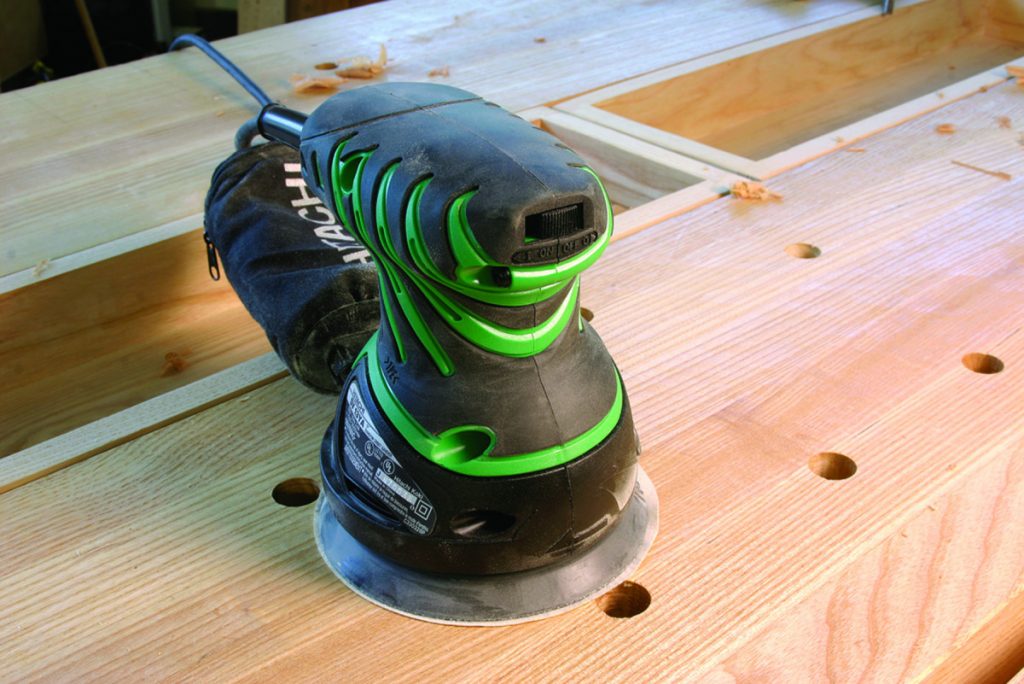
The Hitachi switch is positioned front and center of the tool’s top, but that good location couldn’t offset the negatives of the small size and the harder-than-normal operation.
Sand With Control
Control is determined by how the sander operates. The last thing you want is to have a tool be wobbly, grabby or jumpy. What can cause sanders to perform these unwanted moves? Some of the answer is in the orbit diameter and how aggressive the sander is, as discussed above. Other factors are inside the tool itself and can relate to the motor and gearing.
The smoothest in this category by far is the Festool. But if you study the chart you’ll see the Festool sander has the smallest orbit diameter and it is the least aggressive in the group. According to Festool Product Manager Rick Bush, Festool designed the ETS 125 sander to be a finish sander – a sander for smoothing a surface beyond #180- or #220-grit sanding. The company considers this sander to be a final step in sanding and polishing.
Behind Festool we selected the Ridgid R2600 when evaluating comfort. This sander has a larger orbit diameter and aggressively removes stock. There is no wobbling, so the sanding is very smooth.
Other sanders rated in the top five for smooth operation are the DeWalt, Milwaukee and Hitachi.
The Craftsman and Bosch sanders are the most difficult to control. We could expect that from the Craftsman due to the large orbit diameter, but we were a bit surprised at the Bosch. The ROS20VSK was more than wobbly – almost to the point of feeling unbalanced.
Small Attributes Add Up
Your purchase might be swayed by the little things. Does a longer cord length, lower decibel rating or overall tool weight enter into your equation? Use the information in the chart to reach a verdict.
The editor’s choice is the Ridgid R2600. We like the smoothness of control when sanding and stock removal ranked in the top three. Dust collection is more than adequate and the dust receptacle is threaded onto the tool. And the price, although not the least expensive at $69.97, is just more than the lowest price of all the sanders tested. PW

 Bosch ROS20VSK
Bosch ROS20VSK
The sander gyrates when in use and feels wobbly to the hand. This action could become irritating after prolonged work. The dust receptacle is of a twistoff design utilizing a see-through canister. Dust collection is adequate with residual dust accumulating around the pad and at the bottom of the canister. This tool is set up to use a 1″ hose for an external vacuum. Included with the kit is an adapter to use a 1 1/2″ hose. The speed-adjustment knob is located at the back of the handle making adjustment a two-handed effort and not accomplished on the fly. The sanding pad is dense for improved flat sanding, but contour sanding would be less effective.

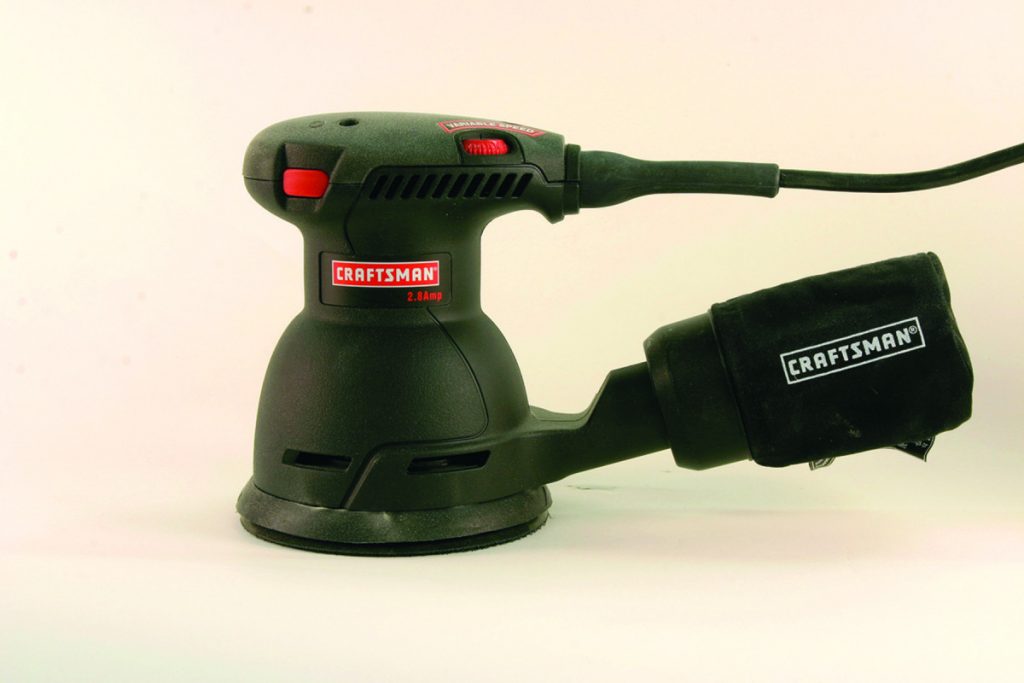 Craftsman 11218
Craftsman 11218
With the largest orbit diameter in the test, the Craftsman sander has a tendency to walk – as you move your hand pressure from side to side, the tool moves in that direction and that increases the likelihood of additional scratch marks as well as escalating sanding time. The dust collection cloth bag fits over a lightweight plastic frame and is attached to the sander with a press-fit. There is no O-ring or gasket to tighten that fit. As a result, there is a noticeable collection of sanding dust along the tool’s base just above the pad, but the workpiece was mostly free from residual dust. This sander is aggressive and ranked second in stock removal. It is the least expensive tool in the test.

 DeWalt D26453
DeWalt D26453
Control of this sander was a bit jumpy as you extend past the edge of your workpiece, but was markedly smooth when sanding flat areas. The grip of the tool is comfortable and rated above average for the test, but additional rubber instead of a textured body would be beneficial. Dust collection is good with a small accumulation at the front of the tool. The cloth dust bag displays little residual dust on the outside, and the workpiece is clean too. A nice feature of this tool is the soft start that reduces the chances of your gouging the surface as you begin sanding. DeWalt has built-in a vacuum adapter for external vacuum use. Two hose coupling sizes are available by simply removing the bag.

 Festool ETS 125
Festool ETS 125
This sander is a fine finish sander that we would happily turn to if we needed a surface polished. Due to its small orbit diameter and its less aggressive stock removal, we wouldn’t choose this tool for our everyday sanding requirements. This is a smooth running tool. The comfort while sanding, as well as the control, are top notch – rated the best of the sanders in our test – but one complaint is the lack of softer rubber on the tool’s handle. Dust collection, without the use of an external vacuum, is better than average, but using paper bags as a dust collection-receptacle is something we would take a pass on. This sander is the most expensive in our test.

 Hitachi SV13YA
Hitachi SV13YA
As you work, control of this sander is relatively smooth, although there is a bit of wobble. Our biggest concerns with the SV 13YA are the on/off switch and the dust collection. We found the switch difficult to operate with a single finger. Hitachi could improve this tool by simply changing to a rocker-style switch. Dust collection rates at the bottom in our test primarily due to the cloth dust bag and the press-on fit of the bag’s frame. Residual dust collects on the bag and on the tool and is evident on the workpiece as well. Also, the inability to connect an external vacuum to this tool in any way (due to the shape of the port) is cause for concern.

 Makita BO5012K
Makita BO5012K
Control is good, but there is a slight vibration and gyration as you work with this sander. The oblong handle fits nicely into your palm, is easy to grip and is comfortable. Dust collection is a cloth bag affixed to a soft plastic transition piece. That transition piece slips onto the tool’s dust port with a press-fit. Also, you have to position the bag correctly to keep the receptacle above the surface of the workpiece. Without the use of an adapter, which Makita sells but doesn’t include in the kit, hookup to an external vacuum is not possible. The BO5012K has a soft sanding pad making it ideal for sanding contours and profiled mouldings. We wish the cord were longer.

 Milwaukee 6021-21
Milwaukee 6021-21
We were pleasantly surprised with this sander. Control is fairly smooth on the flats and a bit grabby around the edges so it gets an average rating. The on/off switch is clearly marked and easily located while operating the tool. The dust collection is far better than many sanders in the test, but we did notice a fair amount of residual dust near the seams on the cloth bag. The dust receptacle twist-locks onto the transition piece and is easy to use. The bag itself slips over a spring that’s attached to the transition piece. This entire assembly is securely affixed to the dust port. One oddity for me as I tested the tools was how the dust-collection assembly angles from the sander; it bumped into me at times.

 Porter-Cable 343SVK
Porter-Cable 343SVK
We found this sander to be a little jumpy. Even on slower speed settings (that are easily adjusted with your thumb as you operate the tool) the sander runs with a jerky motion causing the tool to walk when you change hand pressure. Dust collection is an issue. The canister is tilted toward the sander, and spills dust back toward the dust port after a fair amount of sanding. Also, the canister is attached to a transition piece that is press-fit to the tool. There is an O-ring, but the improvement makes it only slightly better than the previous model. You can bypass these problems with an external vacuum – the 343SVK has built in adapters for two hose sizes.

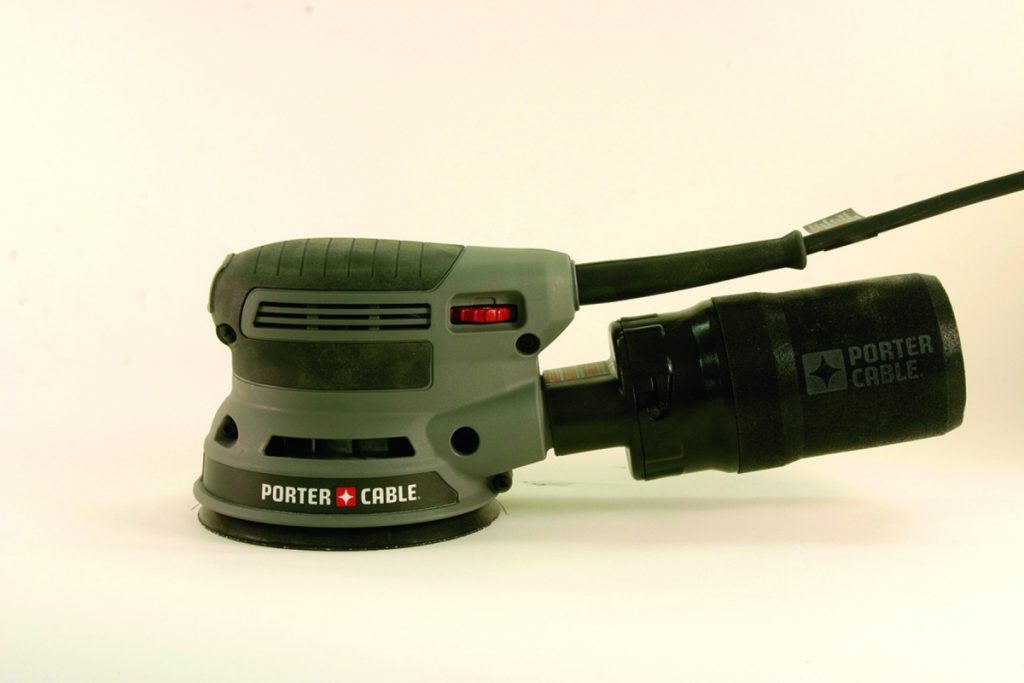 Porter-Cable 390
Porter-Cable 390
This is a new design for Porter-Cable and it looks more like an air-powered sanding tool. It has a low profile that gives you the feel of increased control, but the Endura Tech motor must require a wider tool cap because this is the widest sander tested. Braking is excellent – once turned off, the tool stops quickly. The 390 sander is great at stock removal and is a good choice for flat surfaces. But, if you have to pick up the tool or hold it while you sand, be prepared. This tool has the same issues with the dust canister as does the 343SVK . In addition, we noticed more airborne sanding dust while using this tool.

 Ridgid R2600
Ridgid R2600
This sander rates second for overall control. The operation is smooth without any wobble or jerking motion. The soft-start feature is good, as is the braking, so gouging the surface is not a worry. The best feature of this sander is the method used to attach the dust-collection assembly to the body. A cloth bag is slipped over a sturdy plastic frame that is threaded onto the tool’s dust port. The speed-adjustment knob is easily reached and dialed-in with your thumb. Make adjustments on the fly if you want. The amount of residual dust gathered on the bag was a bit more than we would have liked, but the overall amenities of this sander make it our winner – even if it does have a slide switch.
Here are some supplies and tools we find essential in our everyday work around the shop. We may receive a commission from sales referred by our links; however, we have carefully selected these products for their usefulness and quality.







